24 Hours Hotline: +8613735411378
Email:chengdu@tripstoshanghai.com
24 Hours Hotline: +8613735411378
Email:chengdu@tripstoshanghai.com
Chengdu, the capital of Sichuan Province, is renowned worldwide for its bold and flavorful cuisine. The city’s food culture is rooted in centuries of tradition, with dishes that combine the perfect balance of spicy, sour, sweet, and savory flavors. Chengdu Sichuan food offers an unforgettable experience for food lovers, and its famous dishes are an essential part of any visit to this vibrant city.
Savor Chengdu: A Perfect Blend of Tradition and Taste!
Chengdu is calling, and it's offering a unique blend of old-world charm and new-world excitement. Get lost in the streets where ancient tea houses meet chic cafes, and where spicy Sichuan dishes tantalize your taste buds. Whether you're exploring history or enjoying contemporary culture, we’re here to curate an unforgettable trip that’s as vibrant as the city itself.
Why Explore Chengdu’s Food Culture?
As the capital of Sichuan Province and a UNESCO City of Gastronomy, Chengdu stands at the heart of one of China’s most beloved culinary traditions. Chengdu Sichuan food is known for its bold, complex flavors, which are characterized by the unique use of Sichuan peppercorns and a delicate balance of spice, sourness, sweetness, and savory elements. The city’s approach to spice goes beyond the typical "spicy" stereotype, incorporating the numbing, tingling sensation that Sichuan peppercorns provide, making every dish a sensory adventure. Chengdu's diverse food offerings reflect its rich history and cultural heritage, establishing the city as a gastronomic destination loved by food enthusiasts worldwide.
Must-Try Sichuan Dishes in Chengdu
A. Hotpot
Chengdu hotpot is a culinary institution, loved by locals and visitors alike for its rich, flavorful broths and interactive dining experience. While the spicy hotpot is the most famous variety, Chengdu offers several other types of hotpot that cater to different tastes and preferences. Here's a detailed look at the different types of hotpot you can enjoy in Chengdu, beyond the typical "mala" spicy broth.
1. Spicy Hotpot
The classic Chengdu hotpot, often referred to as mala, is known for its fiery, numbing broth. This broth is infused with Sichuan peppercorns and dried chili peppers, creating a unique combination of heat and numbing sensations that are characteristic of Sichuan cuisine.

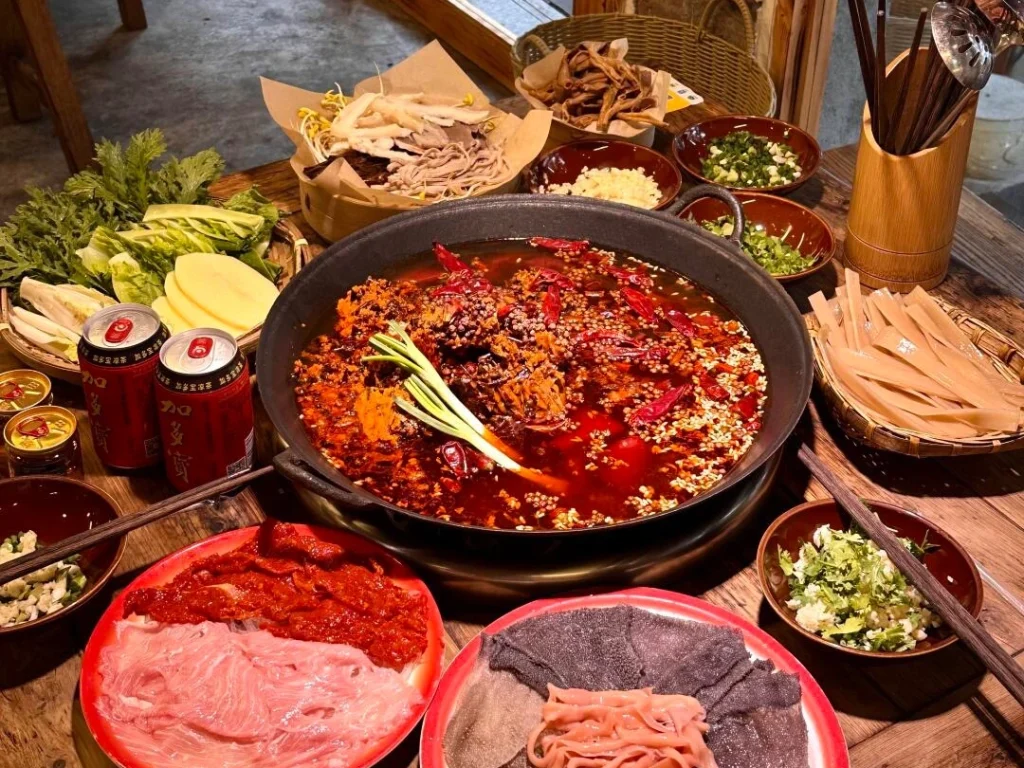
· Key Ingredients: Meats (lamb, beef, chicken), tofu, vegetables, mushrooms, and various dips.
· Why it’s famous: This type of hotpot is the quintessential Chengdu experience, with its intense, bold flavors that ignite the senses.
2. Clear Broth Hotpot
A milder version of hotpot with a clear, light broth that usually features chicken or pork bones. This broth is simmered for hours to extract its delicate flavor, making it a great option for those who prefer a less intense, non-spicy experience.
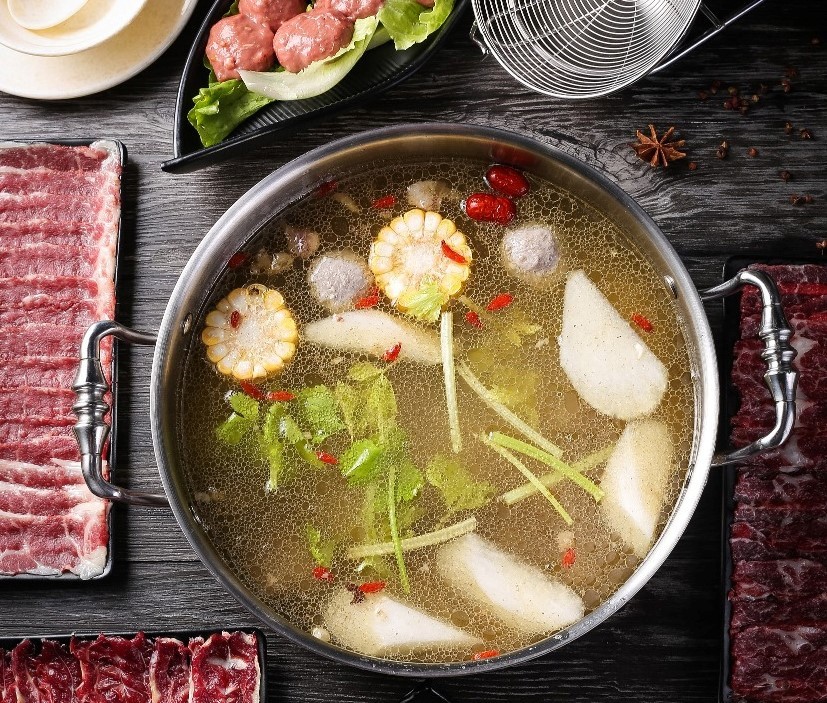
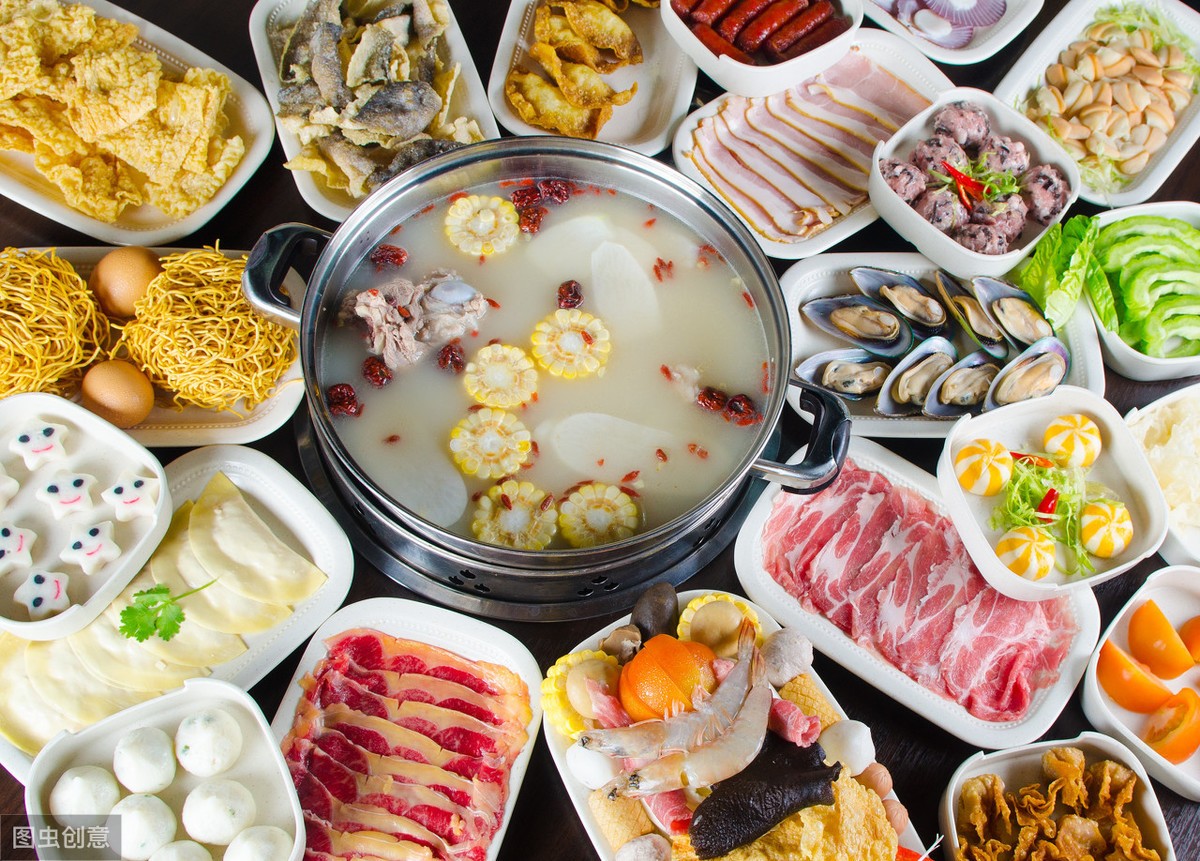
· Key Ingredients: Fresh meats (beef, chicken), tofu, leafy vegetables, mushrooms, and noodles.
· Why it’s great: The focus here is on the natural, subtle flavors of the ingredients, offering a refreshing contrast to the numbing heat of the spicy hotpot.
· Tip: Clear broth hotpot is a great option for those new to Sichuan hotpot, or those who want to enjoy hotpot without the overwhelming spice.
3. Mushroom Hotpot
This type of hotpot uses a broth made with a variety of mushrooms, including shiitake, enoki, and oyster mushrooms, combined with herbs and sometimes chicken stock. The result is a fragrant, umami-rich broth with earthy, hearty flavors.

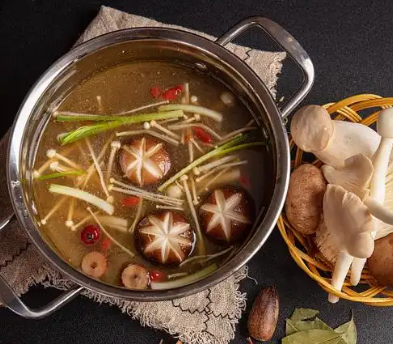
· Key Ingredients: Mushrooms, tofu, meat (optional), and leafy vegetables.
· Why it’s great: Mushroom hotpot offers a deliciously rich and aromatic broth with layers of umami flavors, making it ideal for vegetarians or anyone who enjoys the natural taste of mushrooms.
· Tip: For the best experience, pair the mushroom broth with tofu and fresh vegetables to absorb the broth’s flavors.
4. Tomato Hotpot
Tomato hotpot features a tangy, slightly sweet broth made from ripe tomatoes, sometimes with added herbs and spices. The broth has a refreshing, slightly sour taste that balances out the heaviness of the meats and vegetables.
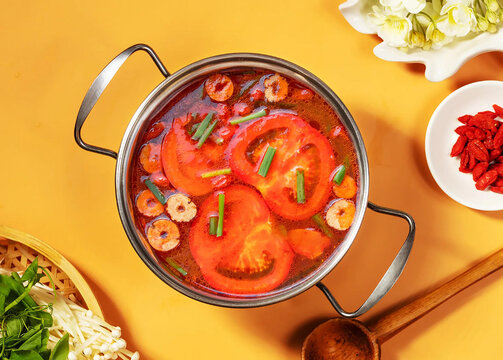
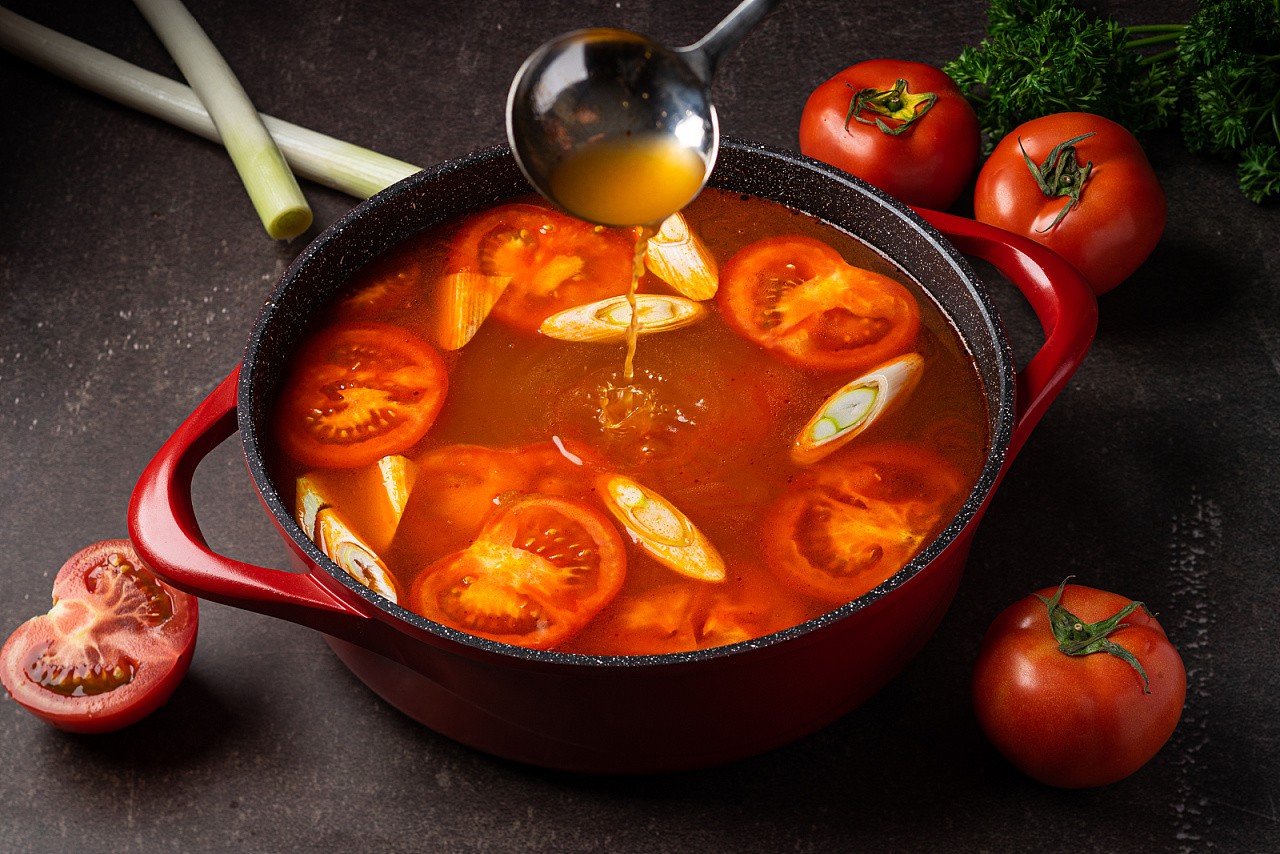
· Key Ingredients: Fresh tomatoes, pork or beef, tofu, leafy vegetables, and noodles.
· Why it’s great: The refreshing and slightly sour nature of the tomato broth provides a wonderful contrast to the richness of the meats and the heat of spicy hotpot.
· Tip: Tomato hotpot is often enjoyed in the summer months for its light and refreshing qualities, making it perfect for a casual hotpot meal.
5. Yin-Yang Hotpot
A popular option for groups, the Yin-Yang hotpot features a divided pot with two different broths: one side with spicy mala broth, and the other side with a milder, non-spicy broth like clear soup or mushroom broth. This allows diners to enjoy the best of both worlds.
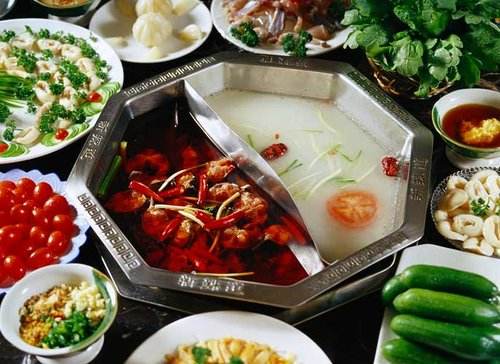
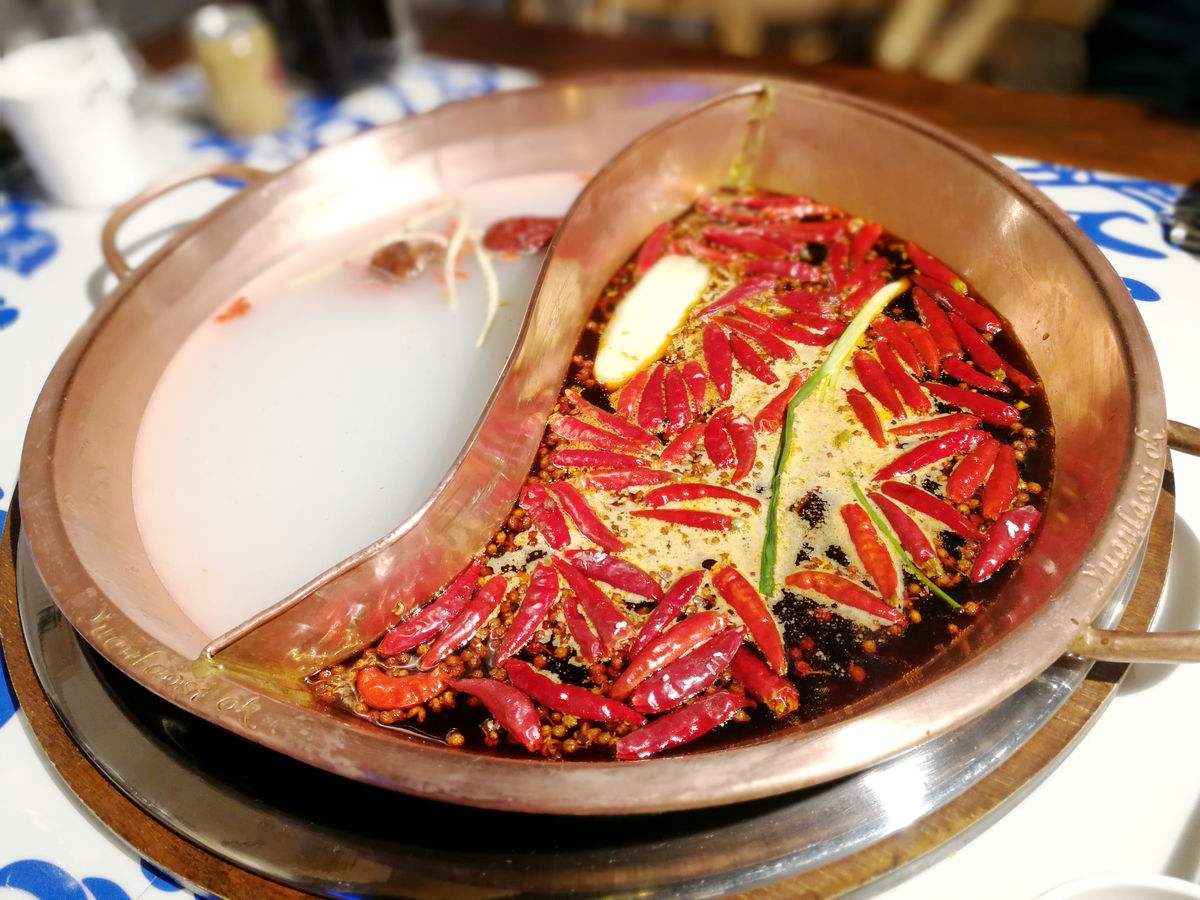
· Key Ingredients: A variety of meats, tofu, vegetables, and noodles that can be dipped into either broth, depending on individual taste preferences.
· Why it’s great: It’s perfect for groups where people have different preferences—those who love spicy can enjoy the mala side, while those who prefer milder flavors can indulge in the soothing clear or mushroom broth.
· Tip: Yin-Yang hotpot is a great choice for people who are new to Chengdu Sichuan food or for larger groups with mixed spice tolerances.
B. Sichuan Cuisine
1. Mapo Tofu
A classic and iconic Sichuan dish, Mapo Tofu features soft, silken tofu set in a spicy, savory sauce made with chili bean paste, Sichuan peppercorns, garlic, and minced meat (usually pork or beef). The result is a dish with a perfect balance of heat and numbing sensations.
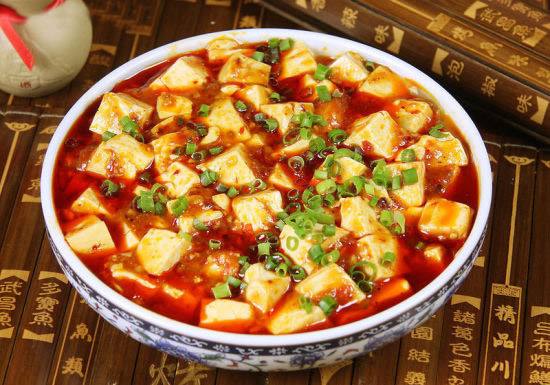
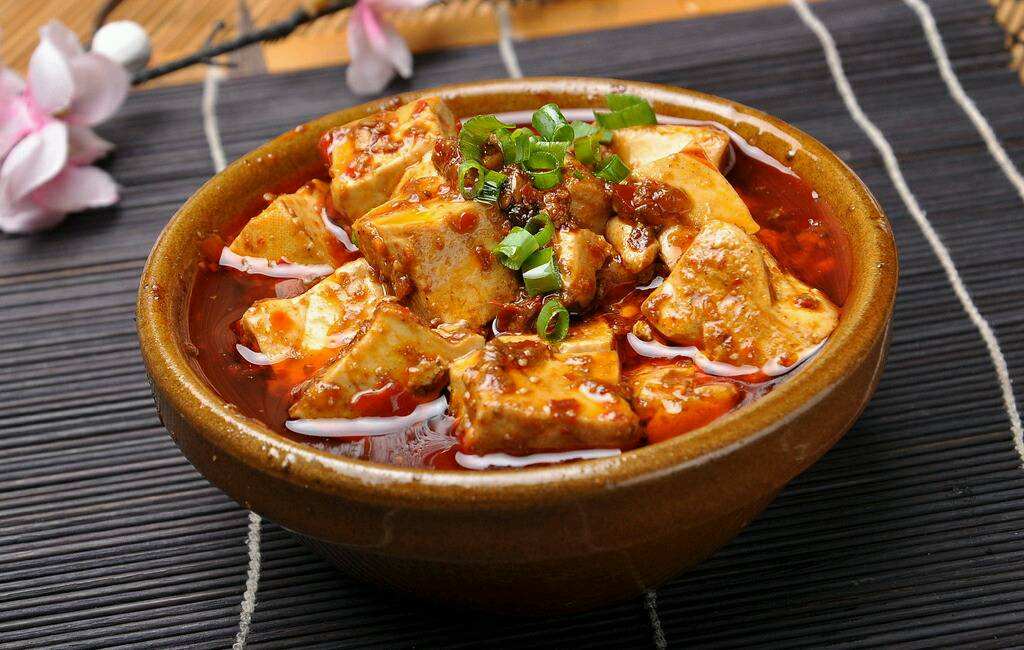
· Key Ingredients: Tofu, minced pork or beef, chili bean paste (doubanjiang), garlic, ginger, Sichuan peppercorns, and soy sauce.
· Why it’s great: Mapo Tofu is the epitome of Sichuan cuisine—a fiery, numbing experience that showcases the perfect blend of spice and umami. The tender tofu absorbs the spicy sauce, creating a mouthwatering contrast between the silky texture and bold flavors.
· Tip: While Mapo Tofu is traditionally quite spicy, you can ask for a milder version if you're not accustomed to the heat. Pair it with steamed rice to help balance the spice.
2. Kung Pao Chicken
A beloved dish both in Chengdu and internationally, Kung Pao Chicken is a stir-fry of diced chicken, peanuts, and dried chili peppers. The dish is known for its sweet, savory, and spicy flavor profile, with the peanuts adding a crunchy texture to balance the tender chicken.
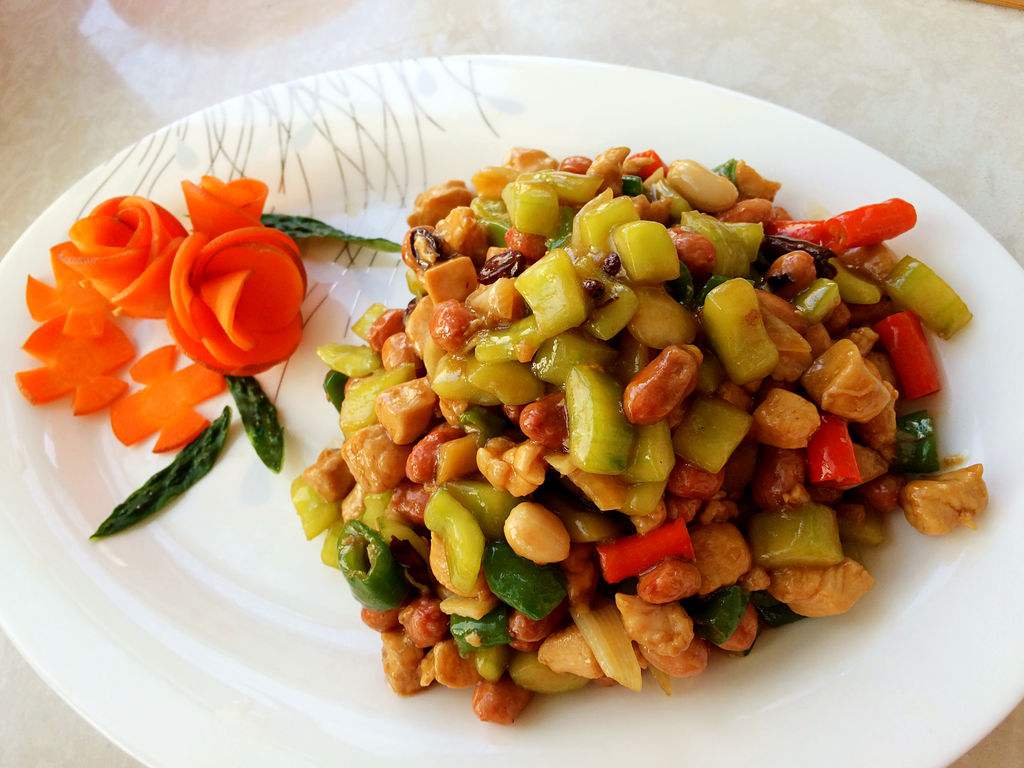
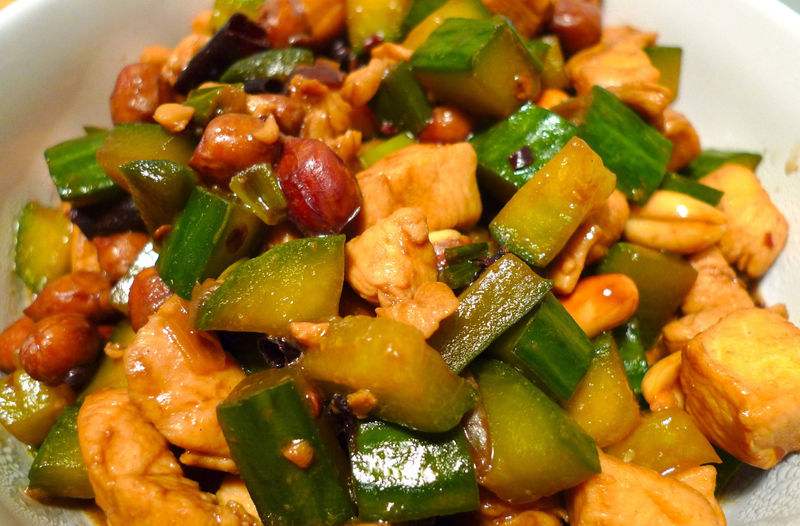
· Key Ingredients: Diced chicken, dried chili peppers, peanuts, soy sauce, sugar, and rice vinegar.
· Why it’s great: Kung Pao Chicken is a deliciously complex dish—spicy heat from the chilies, a touch of sweetness from sugar, and a nutty crunch from the peanuts. It's a perfect example of Chengdu Sichuan food, blending bold flavors into one satisfying bite.
· Tip: If you want to control the spice level, ask for a less spicy version. Pair it with steamed rice to enjoy the full experience.
3. Yu Xiang Rou Si
Despite the name ("fish-fragrant pork"), Yu Xiang Rou Si does not contain any fish. This stir-fry dish features shredded pork in a tangy, spicy sauce made from soy sauce, vinegar, sugar, and garlic, with the distinctive flavors of chili paste and Sichuan peppercorns.
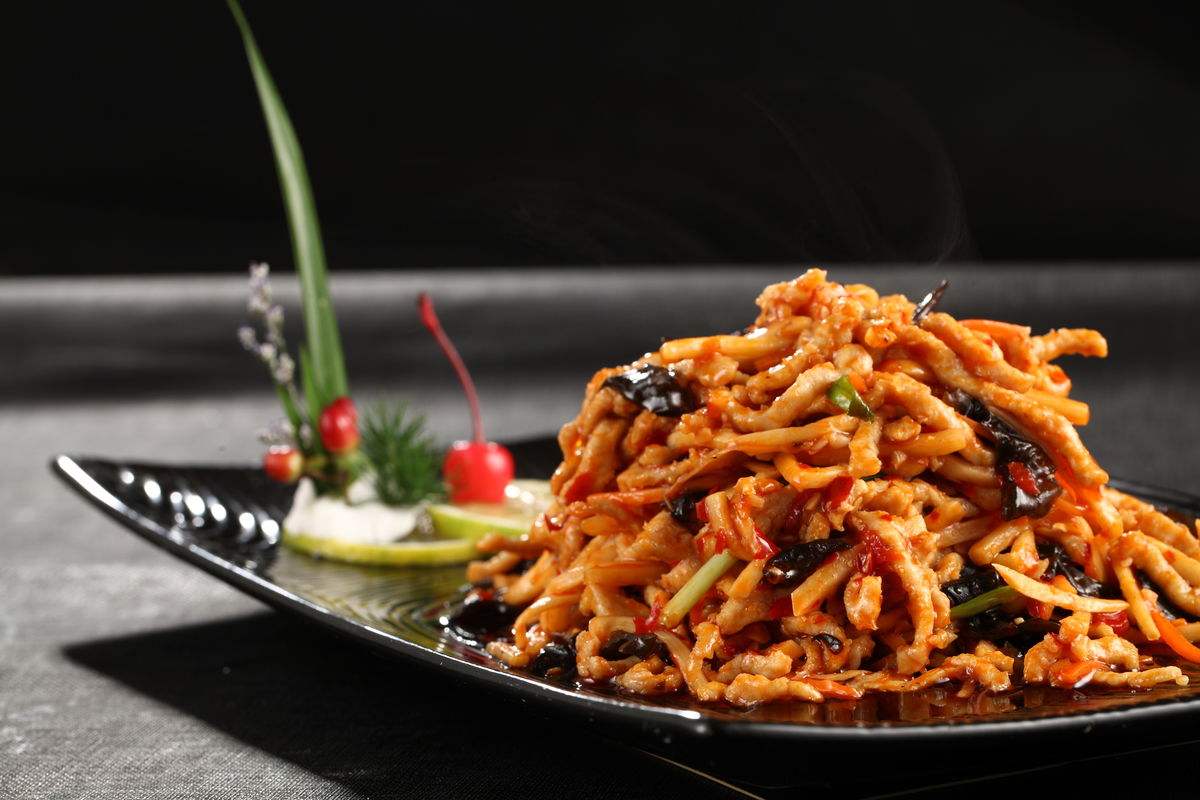
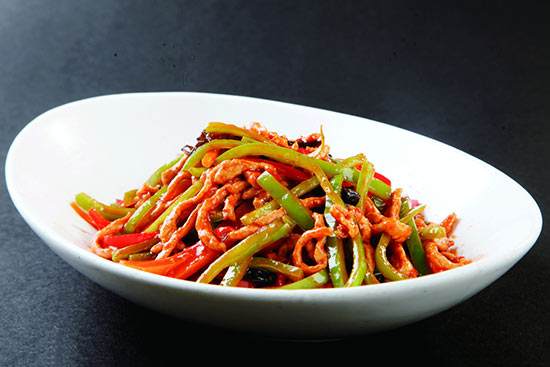
· Key Ingredients: Shredded pork, bamboo shoots, bell peppers, garlic, ginger, soy sauce, vinegar, sugar, and chili paste.
· Why it’s great: Yu Xiang Rou Si is a perfect balance of sweet, sour, salty, and spicy. The sauce is packed with flavors that coat the tender pork and vegetables, creating a complex and satisfying dish that’s full of depth.
· Tip: Though the dish is not spicy in the same way as Mapo Tofu, it still has a bit of heat from the chili paste and Sichuan peppercorns. Pair it with steamed rice to help tone down the spice.
4. Fu Qi Fei Pian (Braised Cow Lungs)
A popular cold appetizer in Sichuan cuisine, Fu Qi Fei Pian consists of thinly sliced beef or offal, typically served with a tangy, spicy sauce made from chili oil, Sichuan peppercorns, garlic, and soy sauce.

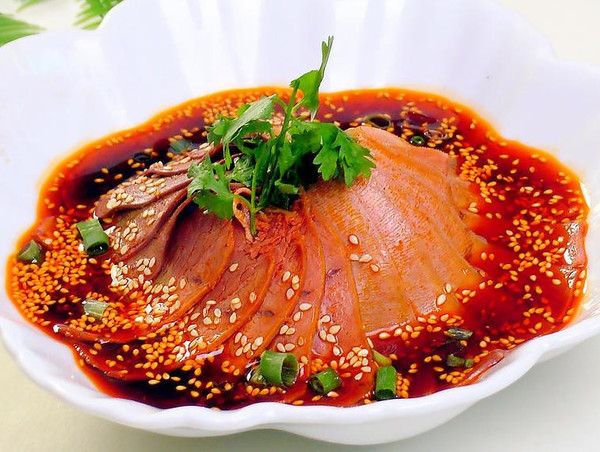
· Key Ingredients: Beef slices, beef tripe, chili oil, Sichuan peppercorns, garlic, soy sauce, and cilantro.
· Why it’s great: Fu Qi Fei Pian is a perfect combination of tender, flavorful beef and offal, dressed in a rich and spicy sauce. The chili oil and Sichuan peppercorns bring a numbing sensation that elevates the meat’s natural flavors. It's an ideal dish for adventurous eaters.
· Tip: Fu Qi Fei Pian is often served cold, making it a refreshing dish, especially in the summer. It’s great for those who enjoy spicy, bold flavors with a touch of tang.
5. Zhang Cha Duck
A specialty of Chengdu, Zhang Cha Duck is marinated with a blend of spices and herbs, then slow-cooked with a layer of fragrant tea leaves, giving the duck a smoky, aromatic flavor. The name "Zhang Cha" refers to the special tea leaves used to cook the duck.

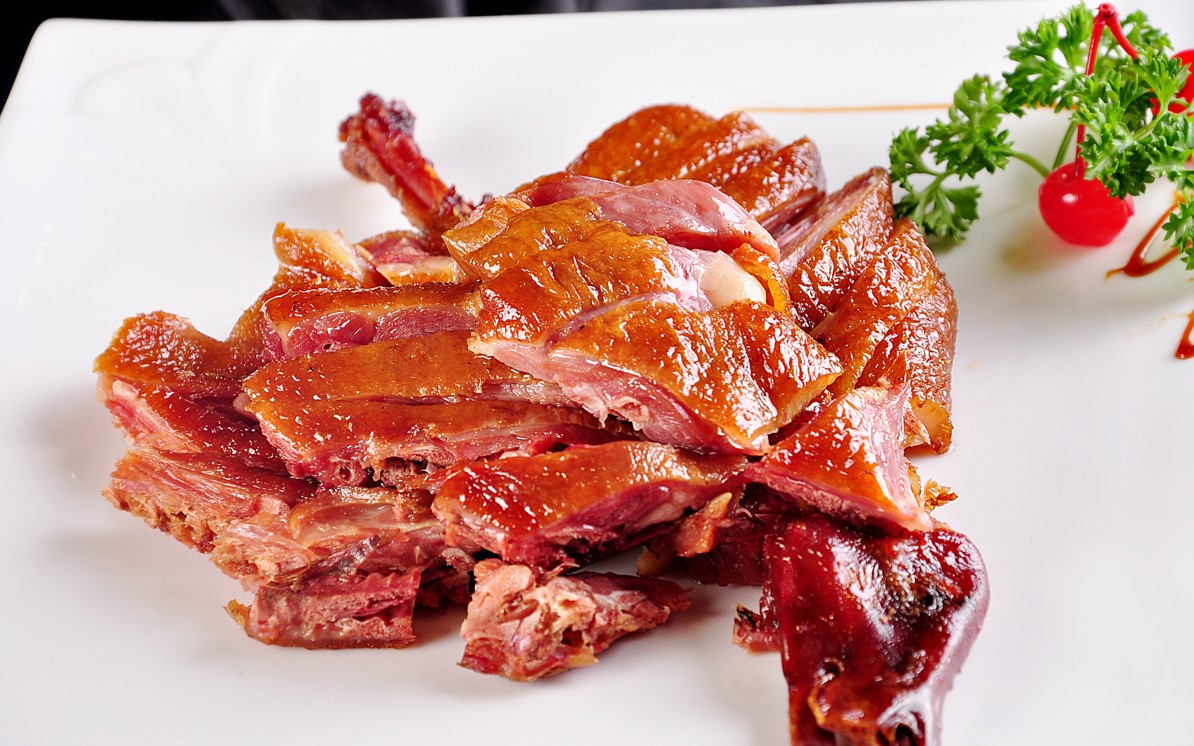
· Key Ingredients: Duck, Zhang tea leaves, soy sauce, spices (star anise, cinnamon), and garlic.
· Why it’s great: The duck is tender and flavorful, with the tea leaves infusing the meat with a rich smokiness and fragrance. The marinade also gives the duck a savory depth of flavor, making it a standout dish in Chengdu Sichuan food.
· Tip: Zhang Cha Duck is often served in chunks with the bones intact, so be prepared to work around the bones while enjoying the flavorful meat. It's perfect for those who enjoy a unique blend of smoky and savory tastes.
6. Lao Ma Ti Hua
Lao Ma Ti Hua is a traditional Sichuan dish made with pig’s trotters (feet) that are simmered in a rich, aromatic broth. The dish features tender, melt-in-your-mouth meat, often served with a spicy sauce made from chili oil, Sichuan peppercorns, and garlic.
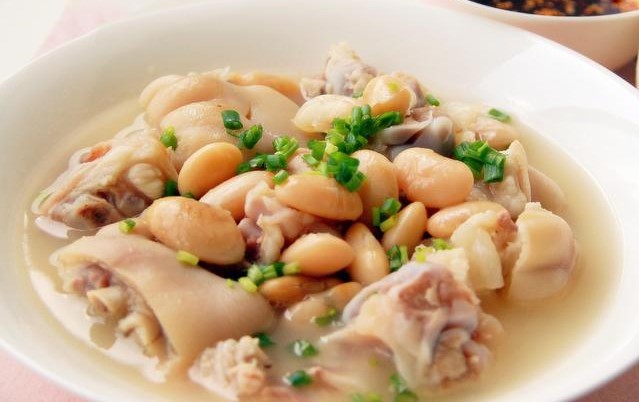
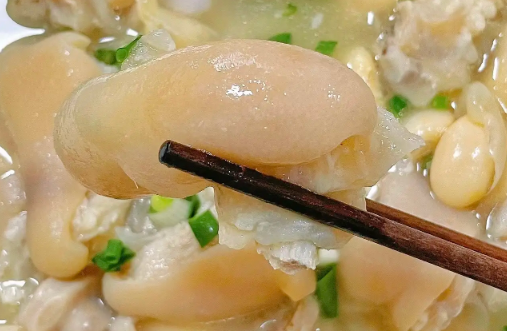
· Key Ingredients: Pig's trotters, chili oil, Sichuan peppercorns, garlic, soy sauce, and spices like cinnamon and star anise.
· Why it’s great: Lao Ma Ti Hua is known for its deep, comforting flavors. The long simmering process results in tender, succulent meat, while the spicy, numbing sauce adds complexity and heat to every bite. It’s a great dish for those who appreciate rich, hearty flavors.
· Tip: Lao Ma Ti Hua is often served as a snack or appetizer, perfect for sharing with friends. It pairs well with steamed rice or a light cold beer.
C. Chengdu Street Snacks
1. Chengdu Skewers
Skewers of meat, tofu, vegetables, and even seafood, all seasoned with a special blend of chili, cumin, and Sichuan peppercorns.
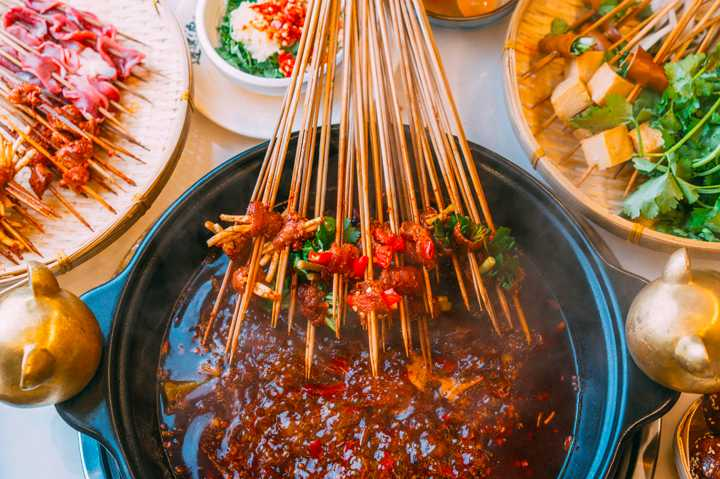
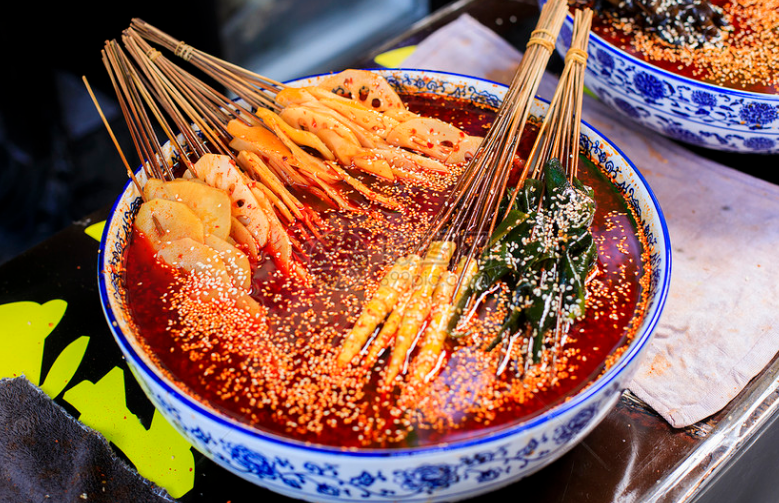
· Key Ingredients: Meat (beef, lamb, chicken, pork), Vegetables (potatoes, mushrooms, cabbage, lotus root), Tofu & tofu skin.
· Why it’s great: These skewers are a street food favorite in Chengdu. You can choose your ingredients, have them grilled on the spot, and enjoy them with a flavorful dipping sauce.
· Where to find it: Numerous street food stalls, especially around Kuanzhai Alley and Jinli Street.
2. Dan Dan Noodles
A spicy noodle dish served with a sauce made from chili oil, sesame paste, soy sauce, and Sichuan peppercorns. The dish is typically topped with minced pork, peanuts, and green onions.
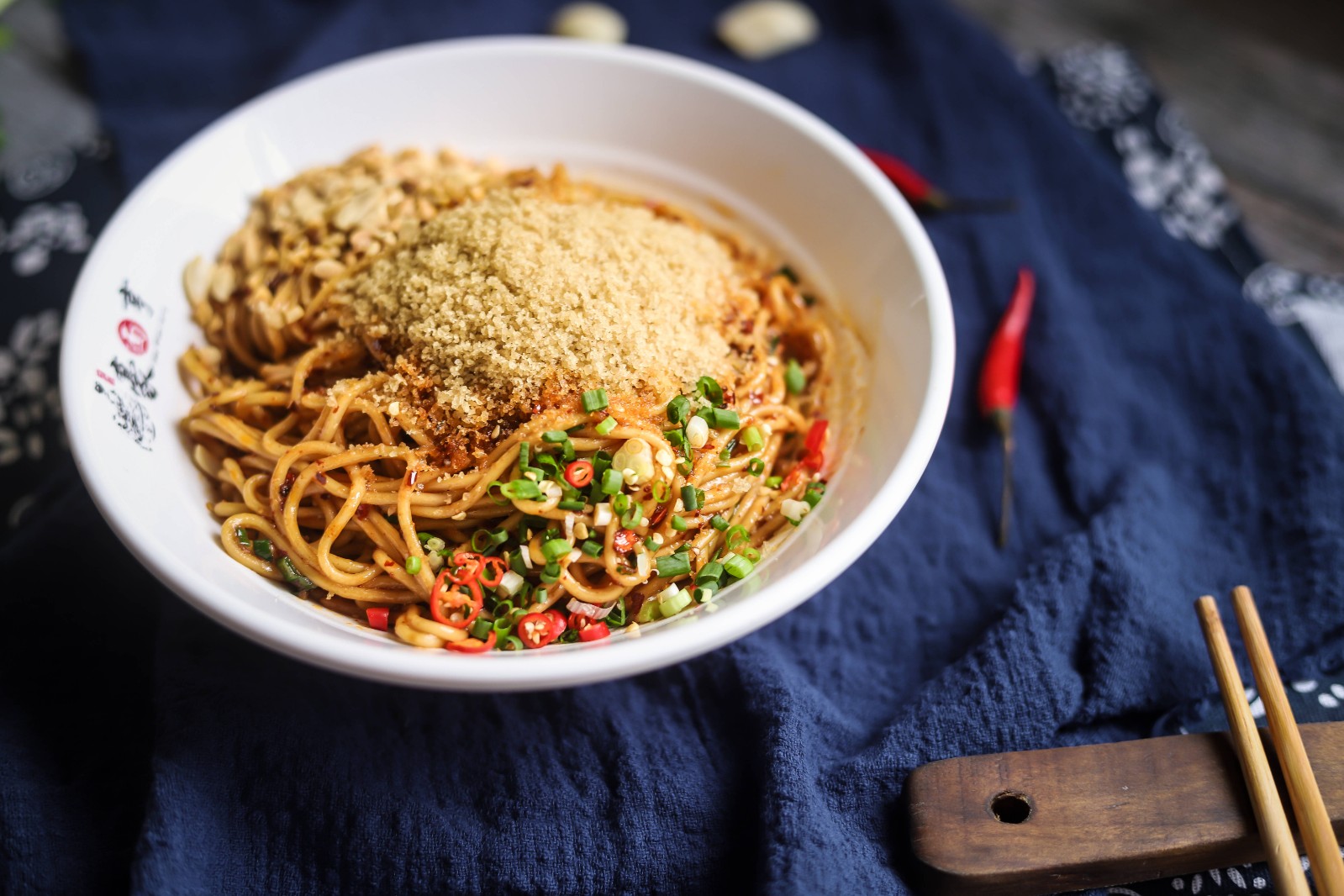
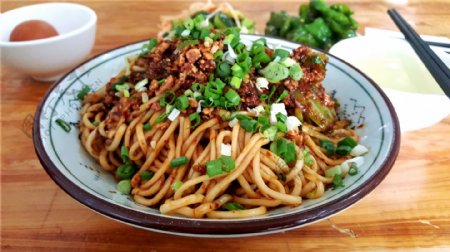
· Key Ingredients: Wheat noodles, Ground pork, Chili oil, Sichuan peppercorns, Sesame paste.
· Why it’s great: It’s simple but packed with bold flavors. The numbing sensation from the Sichuan peppercorns paired with the heat from chili oil makes this a perfect street snack.
· Where to find it: Street vendors throughout Chengdu, especially in the Wuhou Temple area.
3. Spicy Chao Shou
Chao Shou are Sichuan-style dumplings filled with pork or shrimp, served in a spicy, tangy sauce made from chili oil, soy sauce, and sometimes a hint of vinegar. The name "Chao Shou" literally means "folded hands," referring to the way the dumplings are folded into a distinctive shape.
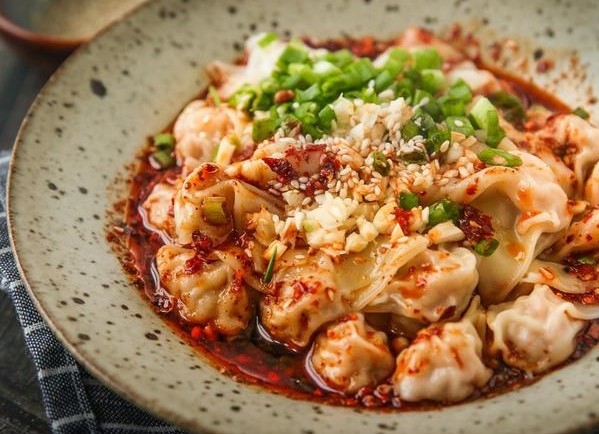
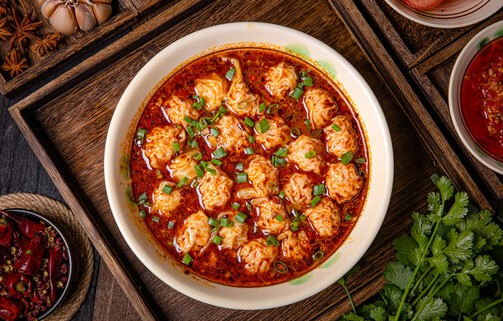
· Key Ingredients: Dumplings (pork or shrimp filling), Chili oil, Soy sauce, Vinegar, Sichuan peppercorns.
· Why it’s great: The Chao Shou are soft and tender, with a delicate filling that perfectly contrasts the bold, spicy sauce. The sauce itself is a wonderful balance of spicy, savory, and slightly tangy, making each bite a mouthwatering experience. This dish captures the essence of Sichuan cuisine with its deep, layered flavors and satisfying textures.
· Where to find it: You can find Chao Shou in bustling street food markets, such as Chunxi Road and Wuhou Temple Market, where local vendors serve up these flavorful dumplings as a popular snack.
4. Bingfen
Bingfen is a refreshing, jelly-like dessert made from the seeds of a local plant, combined with water to form a translucent, soft, and slightly chewy texture. The dessert is served chilled and topped with a variety of sweet and savory toppings, including red bean paste, syrup, crushed peanuts, and fresh fruits.
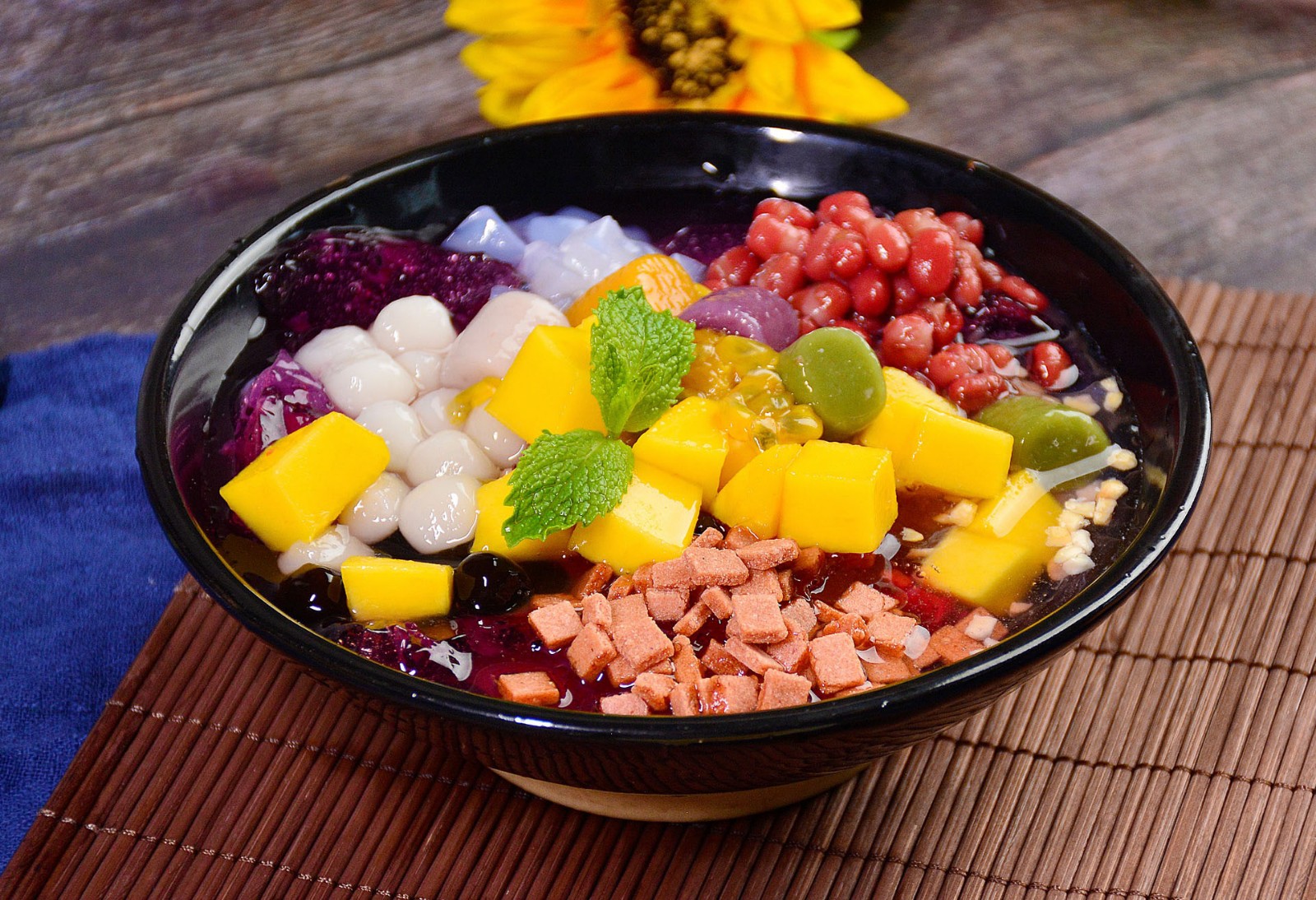

· Key Ingredients: Bingfen (plant-based jelly), sugar syrup, red bean paste, crushed peanuts, fruits (like watermelon, grapes), and sometimes a sprinkling of Sichuan peppercorns for a subtle numbing sensation.
· Why it’s great: Bingfen is the ultimate summer dessert in Chengdu, offering a cooling, refreshing treat that is light and not overly sweet. The combination of chewy jelly and crunchy toppings creates a unique texture and flavor contrast, making it an ideal way to cool off on a hot day.
5. Dan Hong Gao
Dan Hong Gao is a beloved Chengdu street snack made of small, fluffy, golden-brown sponge cakes that are either steamed or grilled. These light and airy cakes are often served warm, with a variety of sweet or savory fillings, offering a customizable experience depending on your preferences.
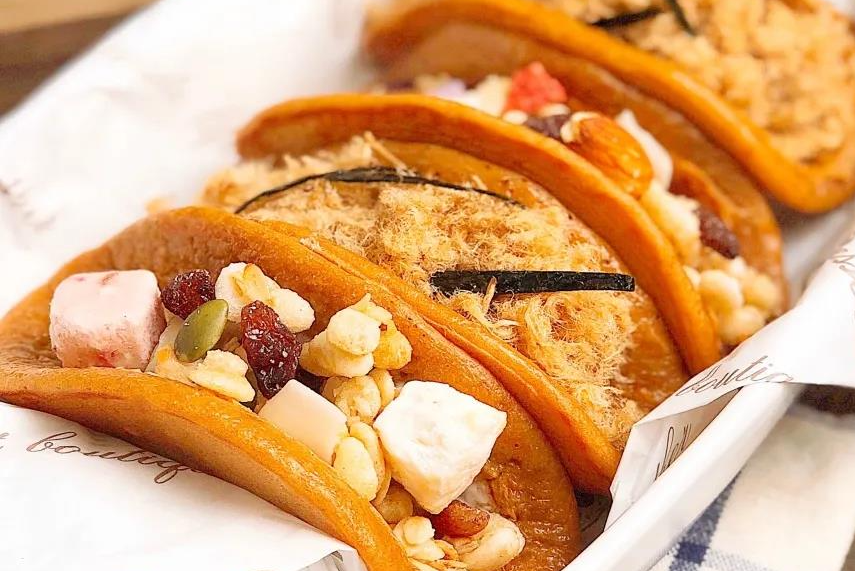
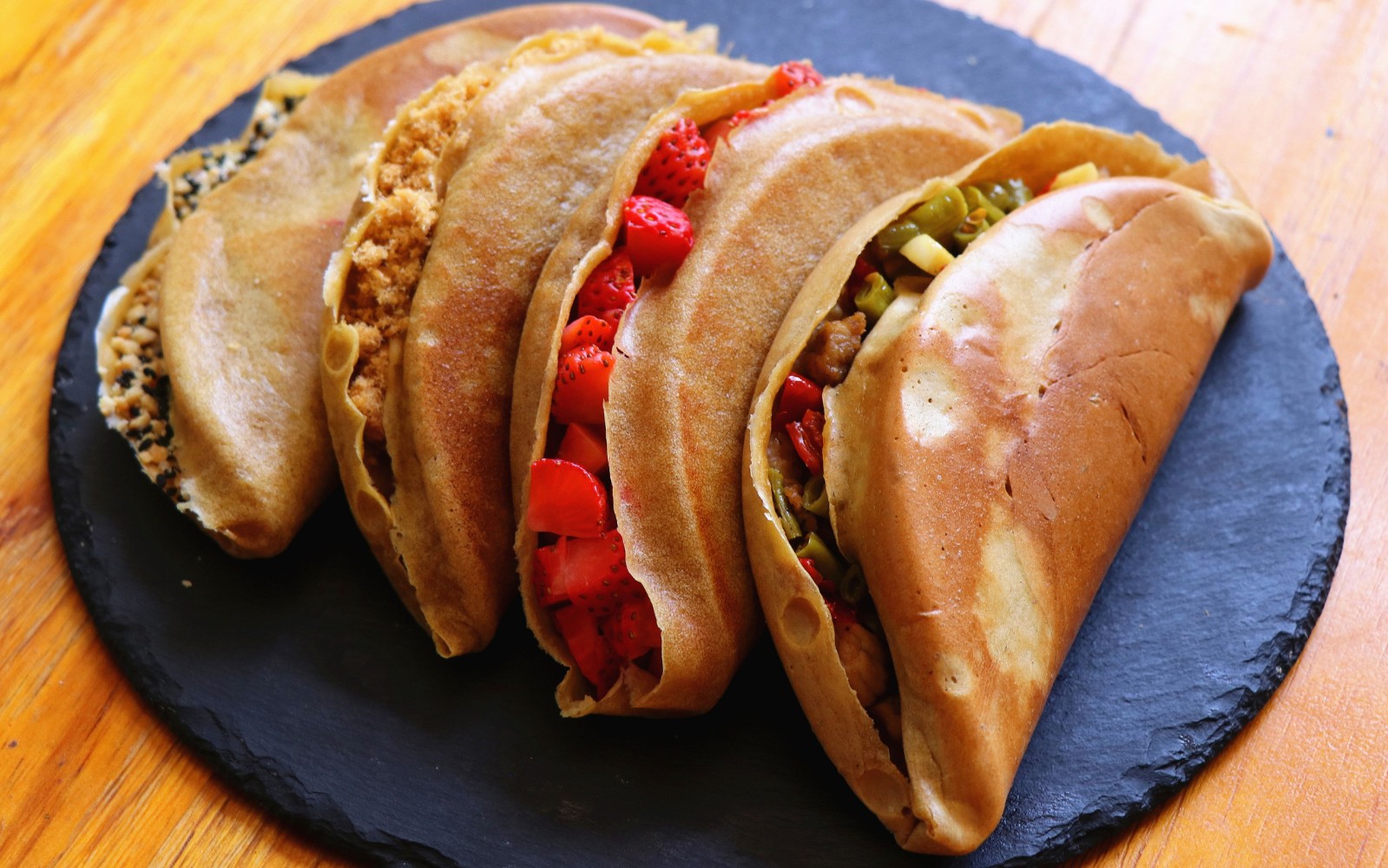
· Key Ingredients: Flour, eggs, sugar, and a choice of fillings, including sweet options like red bean paste or peanut butter, or savory fillings such as pickled vegetables, minced pork, or even cheese.
· Why it’s great: Dan Hong Gao is a versatile snack that caters to both sweet and savory lovers. The cakes are light, soft, and spongy, and when served warm, the filling inside—whether it’s sweet or savory—melts into the cake, making each bite satisfying and comforting. It’s a great snack for anyone who isn’t into spicy food but still wants a flavorful and satisfying bite.
· Tip: Dan Hong Gao is best enjoyed fresh and warm from the grill. Choose your filling based on your mood—sweet for a dessert-like treat or savory for a light, flavorful snack. This is the perfect snack for those looking for a non-spicy option while exploring Chengdu.
6. Sugar-oil fruit
Chengdu's Sugar-oil fruit is a beloved local sweet snack distinct from the traditional Chinese candied hawthorn. It features crispy, fried dough balls coated in a sugary syrup. These dough balls are typically sprinkled with sesame seeds or crushed peanuts to add crunch and flavor, offering a delightful sweet and savory contrast.
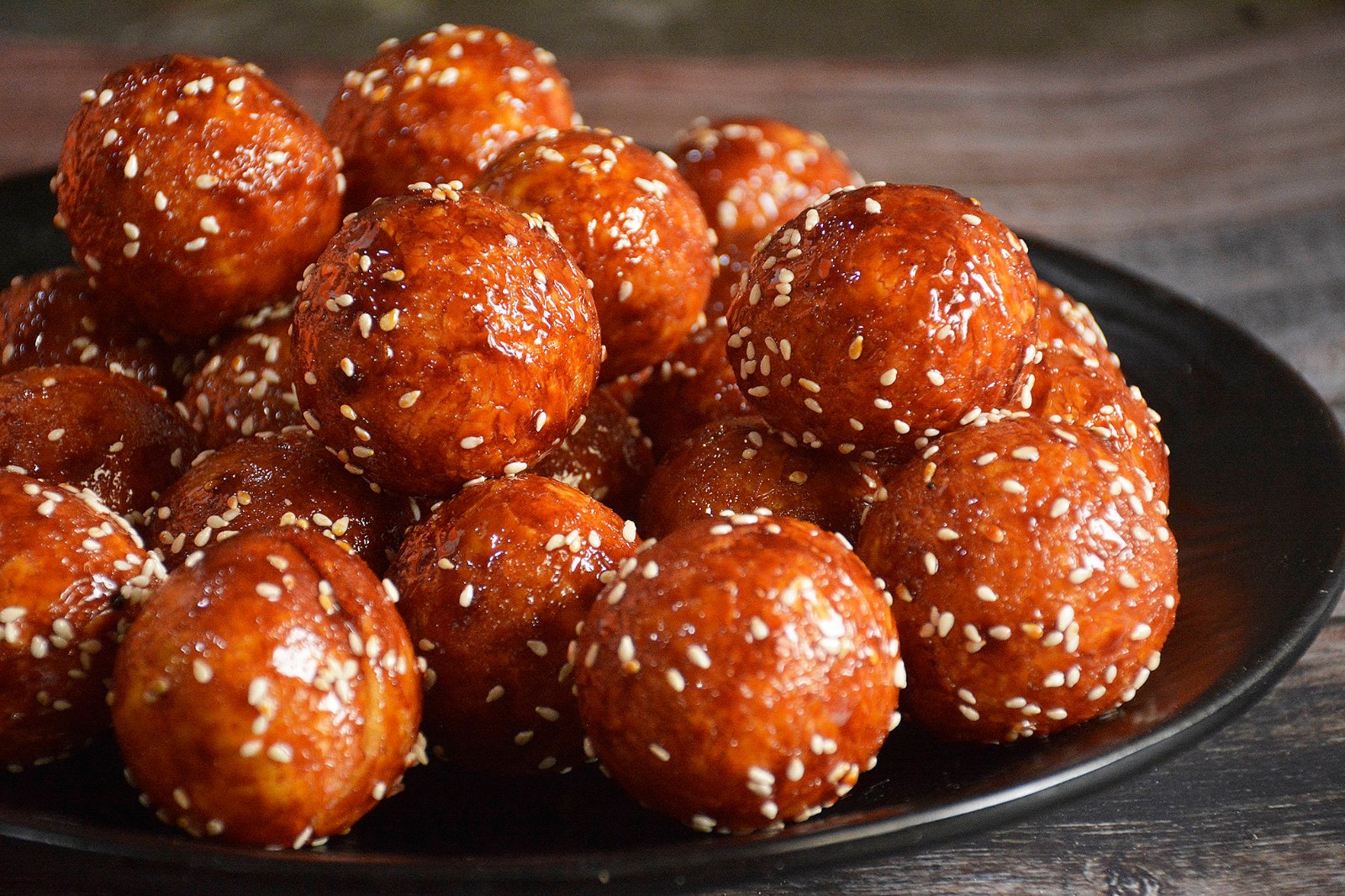
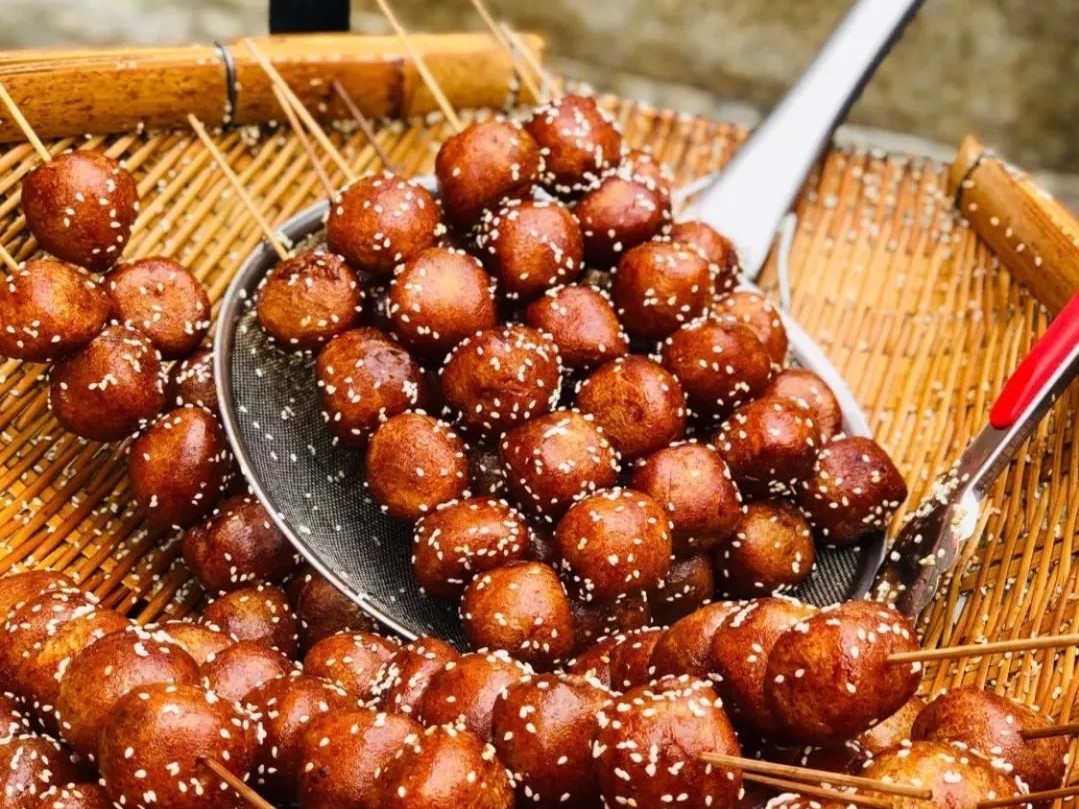
· Key Ingredients: Dough (flour, sugar, water), sesame seeds, crushed peanuts, sugar syrup.
· Why it’s great: Chengdu Sugar-oil fruit is not only delicious but also uniquely comforting. The crispy, warm fried dough balls are coated with a sweet, sticky syrup and then rolled in sesame seeds or peanuts, creating an irresistible balance of sweetness and crunch. It’s a perfect snack to enjoy while exploring the lively streets of Chengdu.
· Tip: While this treat is typically served warm and crispy, be mindful that it’s very sweet! It pairs wonderfully with a cup of tea to balance out the sweetness, and is a fun snack to share with friends during your travels.
7. San Da Pao
San Da Pao is a fun, traditional Chengdu dessert that consists of glutinous rice balls, which are thrown into the air and caught by a bamboo pole. Once caught, the rice balls are covered with a sugary syrup and a dusting of powdered sesame or peanut flour. The name "San Da Pao" translates to "Three Big Shots," referring to the energetic tossing of the rice balls.
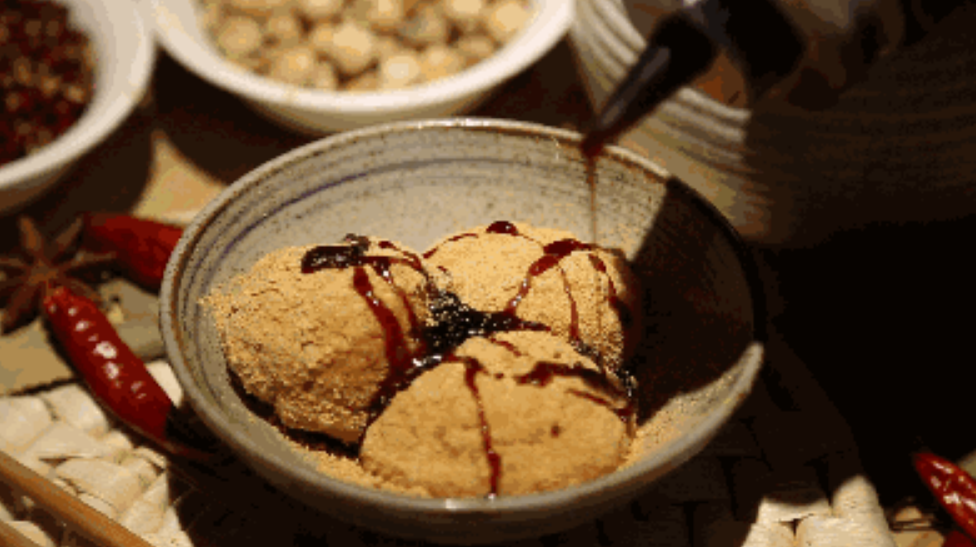
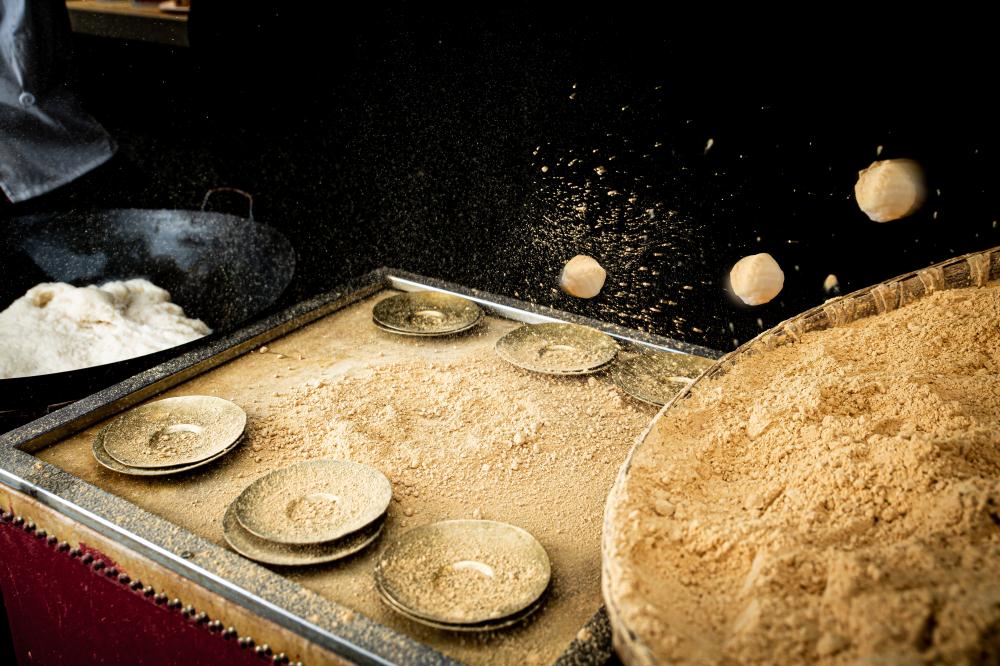
· Key Ingredients: Glutinous rice, sugar syrup, sesame powder or peanut powder.
· Why it’s great: San Da Pao is not only delicious but also a fun experience to enjoy. The chewy rice balls, covered in sweet syrup and powder, provide a comforting texture and flavor. The playful tossing and catching ritual make it a unique and entertaining part of Chengdu's food culture.
· Tip: Be sure to try the rice balls immediately after they are tossed, as the warm, sticky texture and sweet flavor are most enjoyable when fresh.
Chengdu Uncovered: Your Gateway to Authentic Sichuan!
Unlock the hidden gems of Chengdu! From its rich heritage to its cutting-edge art scene, and mouth-watering street food, this city has something for everyone. Wander through tranquil parks, savor local delicacies, and immerse yourself in the laid-back yet lively atmosphere. Let us guide you through a Chengdu experience like no other, tailored just for you.
Chengdu's Food Culture and Dining Etiquette
A. Chengdu's Food Culture
1. The Origins of Sichuan Cuisine
Sichuan cuisine has a long history that dates back over 2,000 years, with its roots deeply tied to the region’s geography, climate, and culture. Sichuan, located in the southwest of China, is characterized by its fertile lands, lush forests, and abundant waterways, making it a perfect place for the cultivation of diverse ingredients. This rich agricultural environment, combined with the region's long-standing culinary traditions, has shaped Sichuan cuisine into what it is today.
The flavors of Sichuan cuisine are influenced by several factors:
· Geography: The humid climate of the region contributes to a cuisine that is designed to balance the body’s internal heat. In traditional Chinese medicine, spicy foods are believed to help balance the body’s “cold” and “hot” elements, which is why spicy and pungent dishes are so prevalent in Chengdu’s culinary culture.
· History: Sichuan’s history of trade and interaction with other regions of China, as well as neighboring countries, has brought a wide array of spices and cooking techniques into the local cuisine, creating a unique blend of flavors that differentiate Sichuan dishes from other Chinese regional cuisines.
2. Spices and Ingredients
What truly sets Chengdu’s food apart is its distinctive use of spices and ingredients, with Sichuan peppercorns and chili peppers forming the backbone of the region’s flavor profile. Sichuan peppercorns provide a unique sensation known as málà, a combination of two key flavors: má, the numbing sensation caused by the peppercorns' active ingredient, which tingles on the tongue and lips, and là, the fiery heat of the chili peppers. This numbing effect perfectly complements the spicy heat from chili peppers, which are another cornerstone of Sichuan cuisine. Dried red chilies and fresh chili paste are used in abundance, adding a deep, fiery heat that balances out the tingling sensation from the peppercorns. Together, this combination of heat and numbness defines the signature málà flavor of Sichuan cuisine, making it one of the most exciting and unique culinary experiences in the world.
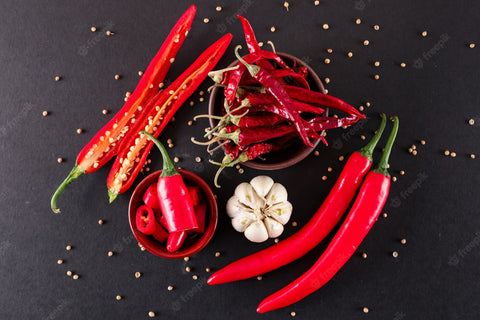

B. Dining Etiquette
1. Communal Dining Culture and Hotpot Etiquette
· Hotpot Etiquette: Hotpot is the most iconic example of Sichuan communal dining. Everyone at the table dips raw ingredients—meats, vegetables, tofu, noodles—into a shared pot of simmering broth, where they cook together. There are two types of broths typically found in Chengdu hotpot: the spicy mala broth and a milder clear broth. The beauty of hotpot lies in its communal nature, where everyone shares a variety of ingredients and experiences different textures and flavors.
· Family-Style Dining: In Chengdu, family-style dining is common, where multiple dishes are placed in the center of the table and everyone shares. Rice and noodles are often served as the base, and the table will be filled with a variety of meats, vegetables, and fish, all served in large communal bowls or platters. It's important to taste a bit of everything to fully appreciate the variety of flavors.
Etiquette Tips:
· Use a shared spoon or chopsticks to take cooked food out of the pot, and avoid dipping the same utensil back into the broth once you’ve used it to pick up food.
· Offer to refill the broth or share the best pieces of meat or vegetables with others at the table. It’s a sign of hospitality and respect.
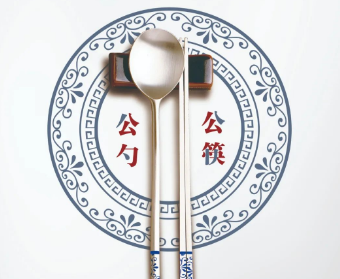

2. How to Politely Navigate a Chengdu Meal
· The Toasting Ritual (Ganbei): One of the most important aspects of Chengdu dining is the act of toasting. If you are invited to a meal, it’s common for the host or elder to offer a toast early in the meal. The phrase “Ganbei” , meaning "Cheers," is often used, and it's customary to take a sip after the toast. When toasting, it’s polite to clink your glass lower than that of the elder or host, as a sign of respect.
· Respect for Elders: In Chengdu, as in much of China, it’s important to show respect for elders at the table. This can include waiting for the oldest person to start eating before you do, serving them the best dishes first, and making sure they have enough food and drink.
· Politeness at the Table: When dining with locals, it's considered polite to take smaller portions of each dish, leaving enough for others to enjoy. Leaving a bit of food on your plate (but not too much) is seen as a sign that you’re satisfied, rather than overly hungry.
· Chopstick Etiquette: Don’t stick your chopsticks upright into a bowl of rice—this resembles a funeral ritual and is considered bad luck. Instead, rest your chopsticks horizontally on the edge of the bowl or use a chopstick rest if available.

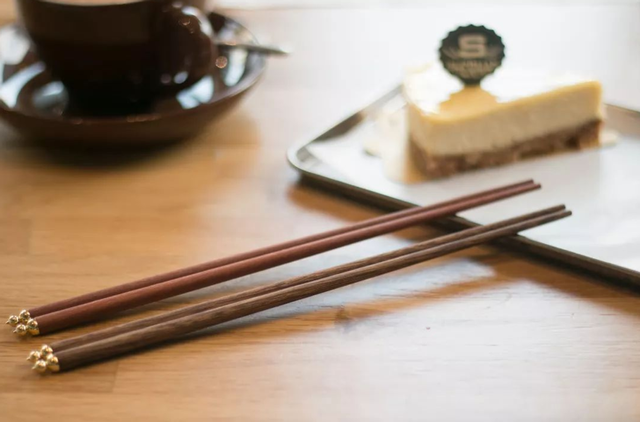
Weather and When to Visit Chengdu for the Best Food Experience
1. Chengdu March weather: Mild weather, making it the perfect time for an outdoor food tour.
2. Weather Chengdu in June: Hot, rainy weather—perfect for cooling off with cold Sichuan dishes.
3. Weather in Chengdu in August: Hot and humid weather; perfect for enjoying cold noodles or cool, refreshing snacks.
4. Chengdu September weather: Warm with occasional rain, ideal for visiting street food vendors.
5. Chengdu November weather: Cooler, but still pleasant; a great time to enjoy warm soups and hotpot.
6. Chengdu weather December: Cold temperatures and potential rainy days; ideal for hotpot or warming dishes.
Tip: Summer (June-August) is ideal for trying cool dishes, while winter (December-March) is best for hot, hearty meals.
Top Food Streets in Chengdu
1. Jinli Ancient Street: A historic street with a bustling food scene, famous for its Chengdu Sichuan food and souvenirs.
2. Wuhou Shrine Area: Explore Chengdu’s history while enjoying local snacks and Sichuan dishes.
3. Chunxi Road: The commercial center of Chengdu, filled with trendy restaurants and street food vendors serving everything from dumplings to spicy skewers.
4. Local Food Markets: Visiting places like Kuanzhai Alley or Zhongshu food market for a more authentic Chengdu experience.
Delicious Chengdu Food to Take Home
1. Sichuan Hotpot Base
A pre-made hotpot base that contains all the essential spices, oils, and flavorings needed to make a delicious Chengdu-style hotpot.
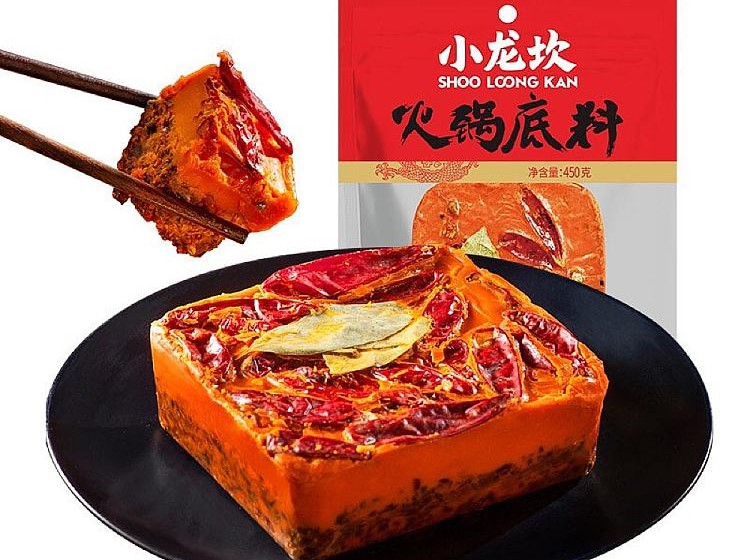

· Why it's great: If you can’t get enough of Chengdu hotpot, this makes a fantastic souvenir to recreate the experience at home. It’s easy to prepare and perfect for sharing with family or friends.
· Where to buy: Hotpot specialty shops or supermarkets around Chengdu.
2. Chengdu Preserved Fruits
Chengdu is known for its preserved fruits, particularly in sweet and tangy flavors. Items like preserved apricots, plums, and lemons are common.

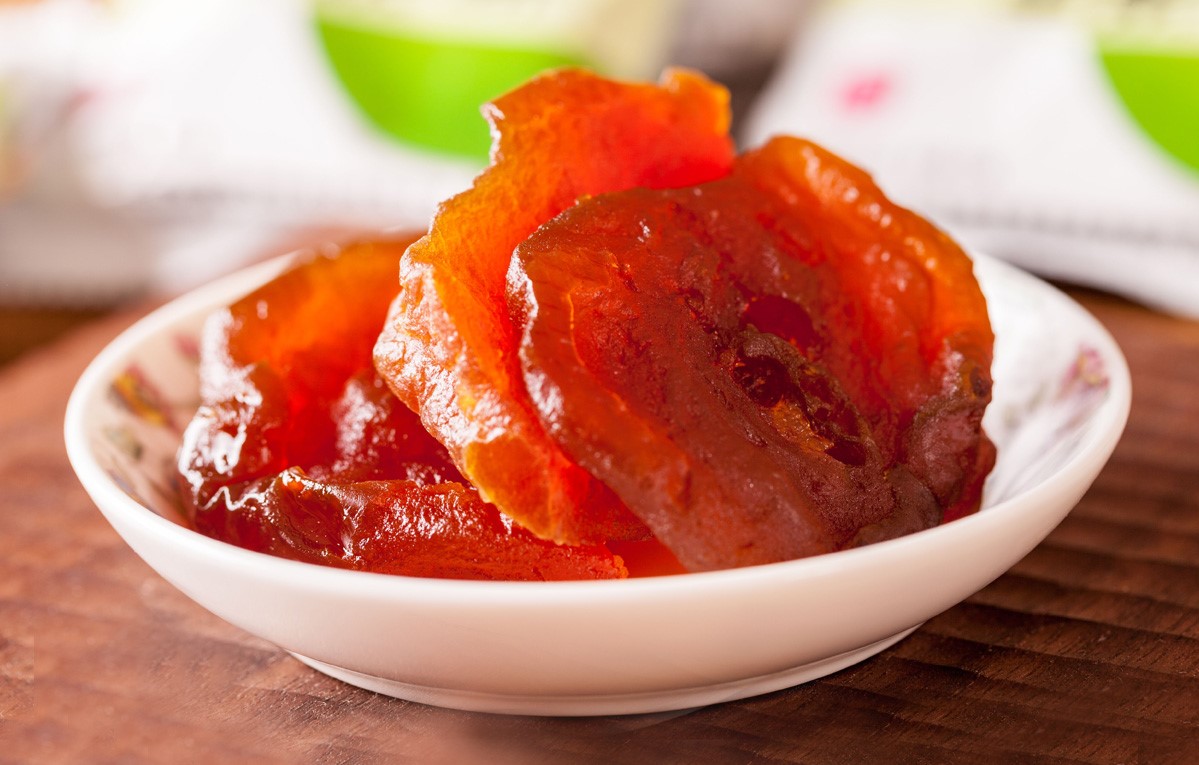
· Why it's great: These make for a unique, flavorful souvenir that can be eaten as a snack or used in cooking. They also have a long shelf life, making them an ideal gift.
· Where to buy: Tea houses, local food markets, or specialty stores in Chengdu.
3. Sichuan Tea
Chengdu is home to some of China’s best tea, including varieties like jasmine tea, oolong, and pu’er. Sichuan tea is often paired with snacks like peanuts and preserved fruits.
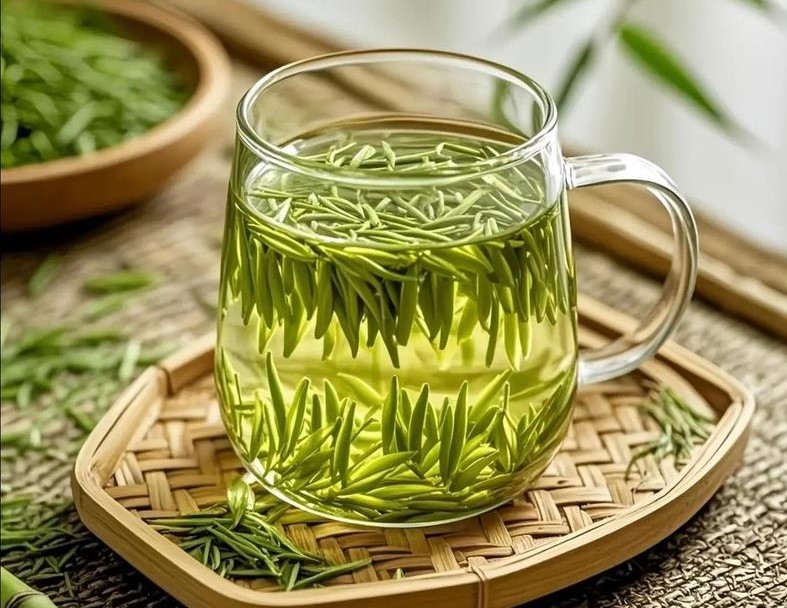
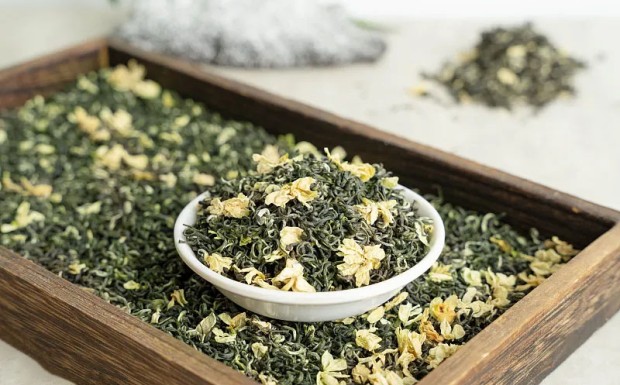
· Why it's great: A perfect souvenir for tea lovers or anyone wanting to experience the calming tea culture of Chengdu.
· Where to buy: Tea houses, specialized tea shops, or markets.
Tips for First-Time Visitors to Chengdu
1. How to Handle the Spice: Chengdu is famous for its spice level, but locals are used to it. Tips on how to enjoy Sichuan food without overwhelming your palate.
2. Chengdu Tea Culture: A quick guide to tea-drinking customs in Chengdu, where you can relax and enjoy a cup of Chengdu famous food in the form of tea snacks and tea ceremonies.
3. Food Tours and Cooking Classes: Participating in a local cooking class or food tour is one of the best ways to experience Chengdu food culture and learn how to make iconic Sichuan dishes.
4. Food Safety Tips: While Chengdu’s food scene is thrilling, it's important to be cautious about hygiene standards when eating at street stalls or busy markets.
5. Language Tips: Common phrases to help with food ordering, especially if you're not fluent in Mandarin.
Your Way Holiday’s Chengdu Sichuan Food Experience Handpicked Famous Food Spots and Culinary Adventures
We design private and tailor-made Chengdu tours customized to your travel style at affordable local prices. You’ll enjoy the comfort of a private, spacious car and the company of a professional local guide with over 5 years of experience, dedicated exclusively to you or your group. From transportation and tickets to authentic dining experiences (we always recommend the dishes most loved by locals), everything will be arranged according to your preferences. Please take a look at some of our most popular Chengdu tours below:
Not exactly what you’re looking for? Don’t worry — all of our Chengdu tours can be fully customized based on your interests, schedule, and budget. We specialize in creating unique Chengdu experiences that go beyond the guidebook, giving you the chance to truly connect with the local culture and people. Our enthusiastic tour experts are always ready to provide detailed suggestions and will respond to your inquiry within 24 hours. Ready to explore Chengdu your way? Contact us today and let us design a Chengdu shopping experience that fits your style. Your Way Holiday looks forward to your message! We're ready to design an unforgettable Chengdu trip for you anytime.
Prev: Weather in Chengdu: A Complete Year-Round Guide to Climate & Travel Tips
Next: Chengdu Culture
Wechat: Chinaprivatetour
24 Hours Hotline:
+8613735411378
1 to 1 tailor-made service from our professional travel advisors for the most sophisticated
Constantly excellent reviews for attraction, hotel and service Competitive price
Local experts provide quality tours Best selected knowledgeable local guides Authentic local restaurants
7*24 hours available to create you a worry-free tour. No Hidden Fees and absolutely no pressure to buy. Secured







